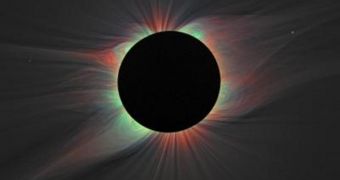Scientists from the American space agency's Goddard Space Flight Center (GSFC) announce that they have managed to discover and figure out another one of the Sun's mysteries. While shuffling through data collected during eclipses, they created the first-ever image of the solar corona in the near-infrared wavelengths that are caused by highly ionized iron. The element, known as Fe XI, “operates” at 789.2 nanometers, they report. Such observations are only possible during solar eclipses, as, otherwise, the brightness of the star conceals this information.
The findings, which were presented on January 4 in Washington DC, at the 215th meeting of the American Astronomical Society (AAS), will also be detailed in the upcoming issue of the respected Astrophysical Journal. The researchers behind the new study say that all the measurements were collected during the 2006, 2008 and 2009 solar eclipses. In charge of the investigation was GSFC astrophysicist Adrian Daw, who collaborated closely with an international team of scientists, under the supervision of expert Shadia Habbal. The scientist works at the University of Hawaii Institute for Astronomy (IfA).
“The first image of the corona in Fe XI 789.2 nm was taken during the total solar eclipse of March 29, 2006,” Daw revealed at the conference yesterday. Later investigations determined that the iron ions the Sun generated did not extend evenly around the star. There are some areas that feature a higher density of them, whereas other regions contain smaller amounts. The observations also determined that the emissions extended very far out from the source, covering an area roughly equal to three solar radii. The distance was equal to 1.5 times the width of the Sun at the equator, the GSFC team revealed.
“These are the first such maps of the 2D distribution of coronal electron temperature and ion charge state,” Daw added. The effort also resulted in scientists determining the distribution of electron temperature and iron-charge states near the surface of the Sun, and beyond, in the solar system. This knowledge is very important in the field of space-weather analysis. If we know the interactions that govern the “weather” in our solar system, then we can extrapolate how these events influence the planet, and how the Earth interacts with the stream of charged particles that permeates the space around it.

 14 DAY TRIAL //
14 DAY TRIAL //